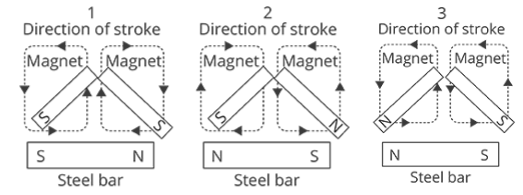Magnetism
In this article, we will study about magnetism and will cover the following sub-topics:
- Properties of magnets.
- Types of magnetic materials.
- Identifying a magnet.
- Magnetic induction.
Properties of Magnets
A magnet has the following properties:
- A magnetic field exists around a magnet and is invisible.
- A magnetic field is a region in which magnetic forces are felt.
- A magnetic force/effect is felt as repulsion or an attraction.
- A magnet has two magnetic poles:
|
- The magnetic effects are the strongest at the poles.
- The law of magnetism states that:
- Like poles repel;
- Unlike poles attract.
Fun Fact
The Earth is one such example of a magnetic material. It is a gigantic magnet. The Earth’s magnetic North Pole is 11.3-degrees away from its geographic North Pole. The main reason behind the Earth being magnetic is its rotation.
Question 1:
Magnets can attract all metals.
Is the above statement true or false?
- True
- False
Answer:
B) False
Explanation:
Magnets do not attract all metals.
Question 2:
Which of the following is NOT a magnetic material?
- Iron
- Nickel
- Copper
- Cobalt
Answer:
C) Copper
Magnetic Materials
- Magnets can only attract magnetic materials.
- Some examples of magnetic materials are iron, nickel, cobalt, and steel.
- Steel is an alloy of iron.
- Magnets have no effect on non-magnetic materials.
- Not all metals are magnetic. Non-magnetic metals include silver and copper.
- Other non-magnetic materials include glass, wood, and plastic.
How to Identify a Magnet?
There are many materials out there; some are magnetic, while others are non-magnetic. In addition, some magnetic materials are made into magnets, while others are not magnets. Therefore, how do we identify if a given material is a magnet?
Question 3:
Which of the following statements is NOT true?
- A magnet can attract magnetic materials.
- A magnet can repel magnetic materials.
- A magnet can attract another magnet.
- A magnet can repel another magnet.
Answer:
2) A magnet can repel magnetic materials.
Explanation:
A magnet always attracts or influences magnetic materials.
Now consider the below image and its interpretation:
If A and B repel each other, it means that both are magnets with fixed poles.
Now, if 2 materials attract each other, especially if they are metallic, then the conclusion is that either one is a magnet. But it cannot be concluded that both are magnets because one of them can be simply a magnetic material only. After all, magnets can attract both magnets and magnetic materials.
Thus, REPULSION is the only true test for magnets.
Now, the question is, why do magnetic materials get attracted to or influenced by magnets? This is due to Induced Magnetism.
Magnetic Induction
When a magnetic material is brought near a magnet, the magnetic material itself becomes an induced magnet. An induced magnet is not a permanent one; its poles can change.
For instance, in the given diagram, there is a magnet and a cylinder (magnetic material). The polarity at the left-hand side of the cylinder will be induced to be the opposite to the magnetic pole near it which is the South pole.
The cylinder has become an induced magnet.
Now, if another cylinder is placed near the previous cylinder, it will also be induced to be a magnet. Hence, this new cylinder will also become an induced magnet.
The induced magnet can now attract other magnetic materials.
What will happen if the real magnet is gone?
The polarity of the first induced magnet, thereby the following cylinder, will also be gone. Thus, the magnet has to be present for induced magnetism to occur.
Conclusion
In this article, we learned about magnetism and the various properties of magnets. We studied magnetic materials and how they become magnets through induced magnetism. In addition, do remember that repulsion is the only true test for magnets
| Continue Learning | |
|---|---|
| Electromagnetic Spectrum | Sound |
| Static Electricity | D.C. Circuits |
| Electromagnetic Induction | Electromagnetism |
| Magnetism | Current Electricity |
| Practical Electricity | |
Test Yourself
When one end of a magnet is brought close to a compass, the pointer of the compass turns and points at the magnet because
I: a magnet always attracts the pointer of a compass.
II: the pointer points at any end of a magnet.
III: the end of the magnet near the compass is a North pole.
IV: the end of the magnet near the compass is a South pole.
The needle of a compass is a magnet. The pointer (North pole) of the compass will only be attracted to the South pole of another magnet, therefore only option D is correct. When there is no magnetic object around, the pointer always points towards the Earth's magnetic North because the pointer is a North-seeking pole.
Ans: D (IV) the end of the magnet near the compass is a South pole.
Which of the following is/are possible result(s) when a steel bar is magnetised by the double stroking method?

At the end of the steel bar where the stroking action ends, the induced magnetic pole will be opposite to that of the magnet's pole.
Ans: (B) 2 only
A steel bar is placed inside a current-carrying solenoid. After some time the steel bar is removed from the solenoid and an iron bar is placed near it. As a result, the iron bar will be ________.
I: repelled by the steel bar.
II: attracted by the steel bar.
III: attracted and then repelled by the steel bar.
IV: repelled and then attracted by the steel bar.
When the steel bar is placed inside a current-carrying coil, it should be converted into a permanent magnet. When an iron bar is placed near the magnetized steel bar, opposite poles will be induced in it and it will be attracted by the steel bar.
Ans: B (II) attracted by the steel bar.




 SG
SG  VN
VN 















